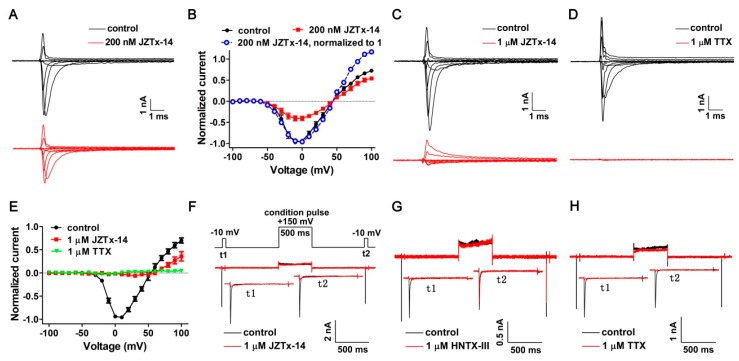Figure 3.
Kinetics of JZTx-14 interacting with NaV1.2. (A) Representative NaV1.2 current traces before and after a subsaturating concentration (200 nM) of JZTx-14 treatment. Currents were elicited by a cluster of depolarizations from −100 mV to +100 mV (in 10-mV increments) from the holding potential of −100 mV. For simplicity, currents in 20-mV increments were shown. (B) I–V relationships of the NaV1.2 channel before and after 200 nM JZTx-14 treatment (black and red solid lines). Currents after toxin treatment were normalized to 1 (blue dashed line) to compare the I–V shape with that before toxin application (n = 10). (C,D) Representative NaV1.2 current traces before and after saturating concentration (1 µM) of JZTx-14 or TTX treatment. Currents were elicited as described in Figure 3A. (E) I–V relationship of the NaV1.2 channel before and after 1 µM JZTx-14 or TTX treatment. TTX and JZTx-14 almost fully inhibited NaV1.2 inward currents, and TTX, but not JZTx-14, fully blocked NaV1.2 outward currents (n = 5). (F–H) The protocol in Figure 3F was used to measure toxin dissociation from NaV1.2 in response to a +150 mV/500 ms strong depolarization by testing the currents in test pulse 2 (t2), and 1 µM JZTx-14, HNTX-III, or TTX were used to fully block NaV1.2 currents in test pulse 1 (t1). A large current recovery was observed in t2 in the HNTX-III group, but not in the JZTx-14 or TTX groups (n = 3–5).

